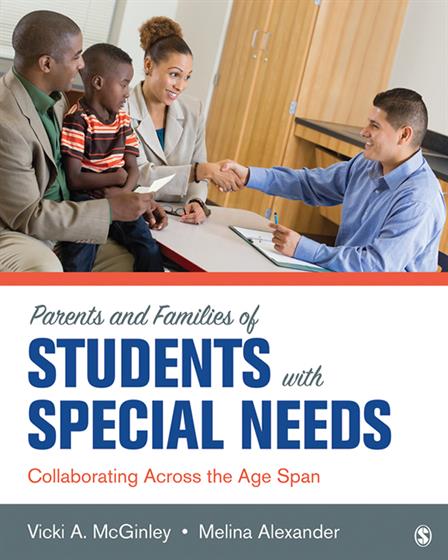Defining the Family
Family Systems Theory
Families of Children At-Risk for Disability
The Professionals and What Are Their Roles?
Family Assessment and Research Based Interventions
The Laws that Support Families
Birth through Age 5
The Primary School Years
Secondary School Years
Post School
Prominent Disabilities Across the Lifespan
Siblings of Children with Disabilities
Section I: FOUNDATIONS, DEFINITION, AND ASSESSMENT
Chapter 1 Defining the Family
The Role of the Family in a Child’s Education
Identifying and Defining Children and the Family
Childhood Living Arrangements
Type of Families
Unique Familial Circumstances that may Influence Education
Educating all Children
Chapter 2: Family Systems Theory
What is Family Systems Theory?
The Family Identity
Family Subsystems
Boundaries
Communication
Cohesion
Adaptability/ Flexibility
Climate
The Family Life Cycle
Factors Impacting Family Systems
External Systems
Coordination of Care
Parenting Relationships
Culture, Race, and Ethnicity
Spotlight on Children in Foster Care
Chapter 3: Families of Children At-risk for Disability
Why Study Risk?
Benefits of Identifying Risk
Definition of Risk
Categories of Risk
Children Living in Poverty
English Learners
Students Experiencing Marginalization
Gifted Children
Developmental Follow-up
Chapter 4: Laws that Support Families
History
Individuals with Disabilities Education Act (IDEA)
Provisions
Section 504
Americans with Disabilities Act Amendments Act
Elementary and Secondary Education Act (ESEA)
Family Educational Rights and Privacy Act of 1974
Chapter 5: The Professionals and Their Roles
Professionals of the Multidisciplinary Team
Benefits of Partnerships
Family-Staff Relationships
Peer Relationships
Building and Sustaining Partnerships
Interpersonal Communication for Partnerships
The Reality of Criticism
Assertiveness Versus Aggressive Communication
Resolving Conflicts
Chapter 6: Assessment to Research-Based Intervention: Providing Families Support
Assessment History and Family Involvement
Working with Families to Understand Assessment
Technical Assessment Terminology
Lifespan Assessment
Transition from Part C to Part B
Primary School Years
Secondary School Years: Transition Assessment
Specialized Assessment and Disability Related Assessments
Disability Specific Assessments
Alternative Assessments/Authentic Assessments for Children with Disabilities
The Assessment Report/The Evaluation Report
Making Instructional Decisions for Intervention
Chapter 7: Siblings of Children with Disabilities
Special Relationship
Importance of Siblings and Significance in Today’s Society
Lifelong Relationship
Interactional Dynamics and Relationship Patterns
Children and Adolescent Siblings
Adult Siblings
Temperament
Sibling Effects
Expectations
Characteristics of Sibling Without Disability
Sibling Interactions
Coping and Stress Styles
Strategies to Help Siblings
Siblings as Teachers
Ways to Establish Sibling Teaching Program
Social Interactions
Counseling Siblings
Section II: WORKING WITH FAMILIES OF CHILDREN WITH DISABILITES ACROSS THE LIFE SPAN
Chapter 8: Specific Disabilities Across the Lifespan
Disability Related to Birth Through Age 5
Disability Related to Primary Years
Disability Related to Secondary School Years
Discovering the Presence of a Disability
Selected Disabilities and their Impact on Families
The Benefits of Home-School Collaboration: Teacher and Families working together
Chapter 9: Birth Through Age 5
Children From Birth to Age 3
Early Intervention
Part C of the IDEA
Individual Family Service Plan (IFSP)
Members of the Multidiscilinary Team
Provider(s) of Early Intervention Services
Early Intervention Programming
Members of the Multidisciplinary Team
Content of the IFSP
Outcomes of Early Intervention
Children Ages 3 to 5
Children Ages 3 to 5 With Disabilities
Preschool Programs
Supporting Families with Children With Disabilities Ages Birth Through 5
Chapter 10: The Primary School Years
Communicating with Families
Transition to Elementary School
The Individualized Education Program Plan (IEP) Process and Document
The Individualized Education Program Plan
Working Together – The IEP Team and the Collaborative Team Model
Collaborative Team Model
Chapter 11: Secondary School Years
Adolescence
Early Adolescence
Middle Adolescence
Late Adolescence
Adolescents with Disabilities
Families of Adolescent Students with Disabilities
The Multidisciplinary Team During the Secondary School Years
Roles of Members of the Multidisciplinary Team
Issues Addressed by Multidisciplinary Team During the Secondary School Years
Potential Needs of the Family During the Secondary Years
Chapter 12: Postschool
Post School Outcomes
Predictors of Postschool Success
Age of Majority
Entitlement Versus Eligibility
Understanding Concerns, Knowing Options, and Creating Partnerships
Current Statistics and Optimistic Trends
Career Development
Employment Settings
Rights, Accommodations and Self-Disclosure
Federal Benefits
Common Questions from Families Regarding Specific Issues Related to Employment
Strategies for Partnering with Families
Postsecondary Education
Postsecondary Education Options
From Entitlement to Eligibility
Accommodations
Social Life and Campus Participation
Financial Factors
Strategies for Partnering With Families
Independent and Interdependent Living
Development of Life Skills
Support From State and Federal Government
Types of Residences
Social Relationships and Community Participation
Strategies for Partnering With Families



